
To further study control and maintenance of the economy through control of the Circulating Money, we need to ascertain where money comes from. I have used various ways to explain the origin of new money and found that the easiest to understand is a look at the 2015 figures from the Reserve Bank of Australia. To date, the Reserve Bank of Australia has created $67 billion in Cash Currency [Reserve Bank of Australia.]. This is the folding notes that one finds in one’s wallet. This $67 billion is the total of all Legal Tender Cash Currency created by the Reserve Bank. However, the Reserve Bank lists the total money in Australia (M3) to be ~$1760 billion. This clearly did not come from the Reserve Bank. The Reserve Bank has created a total of $67 billion in Cash Currency, yet they list the total Money Supply as ~$1760 billion. It came from, other than the Reserve Bank. This ~$1700 billion appears in bank accounts but did not come from the Reserve Bank. From where did this money come? More in a moment. The next surprising figure is the sum of government debt and private debt. When I add the total Government Debt to the Private Debt (house mortgages, car loans, credit card debt, etc.), the total debt equals $5400 billion. [7] Australia has more debt than money. The volume of debt exceeds the volume of money by a factor of three. I originally thought that I had made a gross error, so I checked in numerous ways, but could find no error. I developed various models to demonstrate that it was possible to have ‘more debt than money’. To confirm my findings for Australia, I checked the figures for other countries. Europe has debt exceeding money by a factor of about 2.6. Greece is about three. The UK is about 2.6. The USA is above three. When the figures are added for all countries for which figures are available, we arrive at a worldwide figure of two times as much debt as money. There is twice as much debt in the world as there is money. I give you the following graphs:

I have created the following graphs for your amusement:

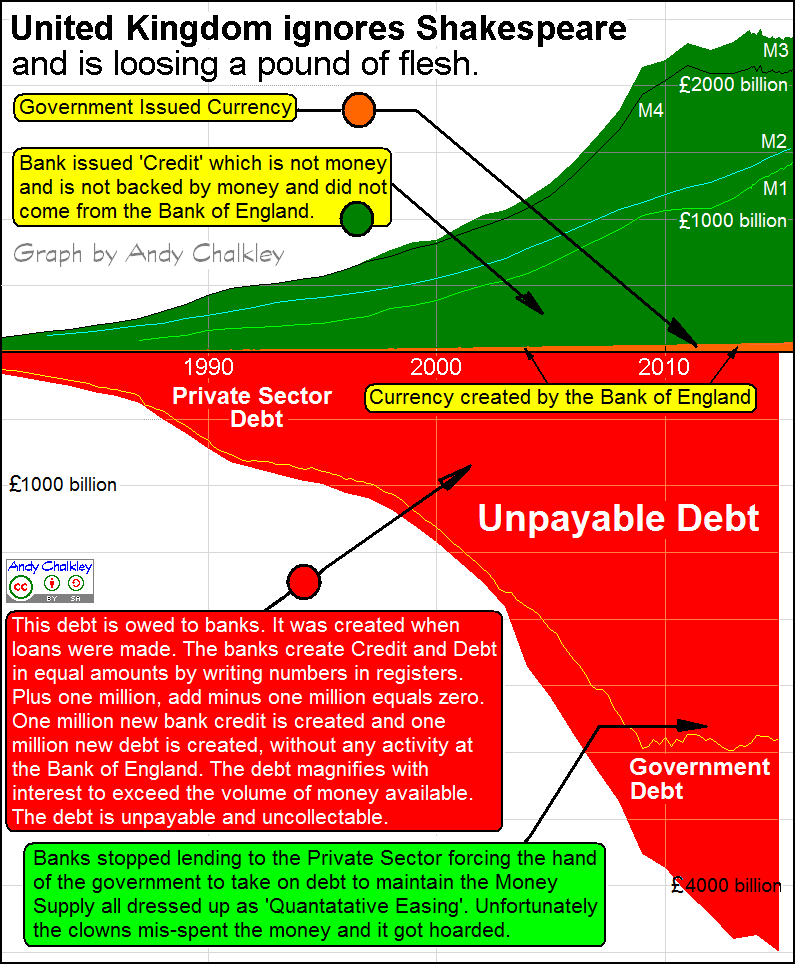


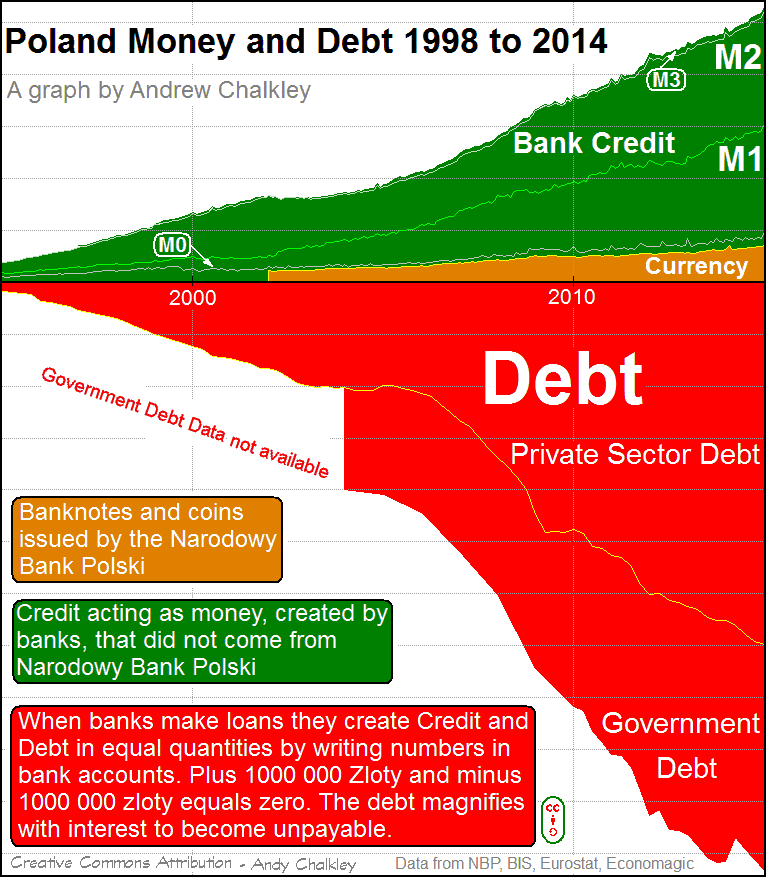


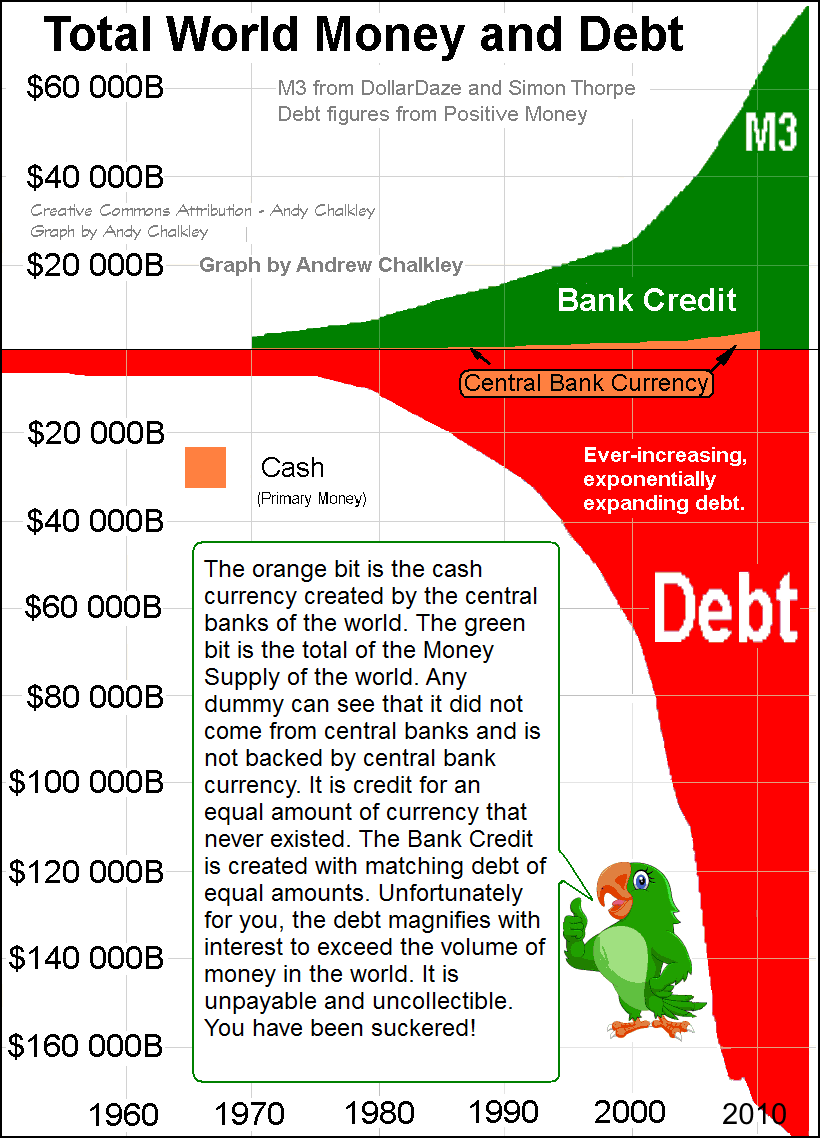
Send me an email if you want me to do a graph for your country. The graphs are fascinating. Notice that the Cash Currency component is a somewhat insignificant component of the Money Supply. The bulk of the Money Supply is bank credit.
It turns out that the so-called money that we have listed in our bank accounts, is not money as we think of it. It is credit. It is the amount that the bank owes you in Cash Currency, payable at some date in the future. It is credit on the bank’s books which you can transfer to others as a means of payment. It is Bank Credit that is equal in value to the Cash Currency created by the central bank and is freely converted to Cash Currency. It did not come from the central bank. The banks of Australia do not have $1760 billion of cash sitting in vaults and $1760 billion of cash does not exist. Only $67 billion of cash exists and much of that is in people’s back pockets. $67 billion is the sum total of all the currency created by the Reserve Bank. Now we sniff out where the money listed in bank accounts originated. The Reserve Bank of Australia has created $67 billion of Cash Currency. The government does not pay its bills using cash. The government pays its expenses using bank accounts. Consider what you do if you want money. For little items, you pay with cash or from a bank account. For large items, you will borrow the money. And that is the clue. If you want more money, you borrow it. Money is available if you borrow it. Almost all money in use is borrowed money that is being passed from citizen to citizen. The money in your bank account probably came to life as a mortgage loan and the positive book entry is getting passed from person to person as a means of payment. The proceeds of the loan are transferable. Banks seem to have a never-ending supply of money to lend. It appears to come from nowhere. But they are lending you credit, not cash.
Now we shall consider the borrowing mechanism. You walk into a bank and ask for one million dollars to buy a house. The bank officer looks you in the eye and says: “You are a good person. You have a job. Our bank will lend you the money.” On the appointed date, the bank writes one million dollars with a plus sign next to it, in the seller’s account. It writes one million dollars against a new loan account in your name, with a minus sign next to it. One million dollars with a plus sign and one million dollars with a minus sign makes zero.

From that moment, there is one million dollars more money in the nation and one million dollars more debt. No transaction occurred at the central bank. No cash money moved from a vault. No customer deposits were required. Hopefully, you can conclude that money creation occurs when banks lend money. A problem is created when the debt is magnified with interest.

At the end of the first year, you owe one million plus ten percent. At the end of the second year, you owe one million dollars plus ten plus ten, and so on. The debt magnifies to exceed the money of the nation. This is one of many ways of arriving at this conclusion.
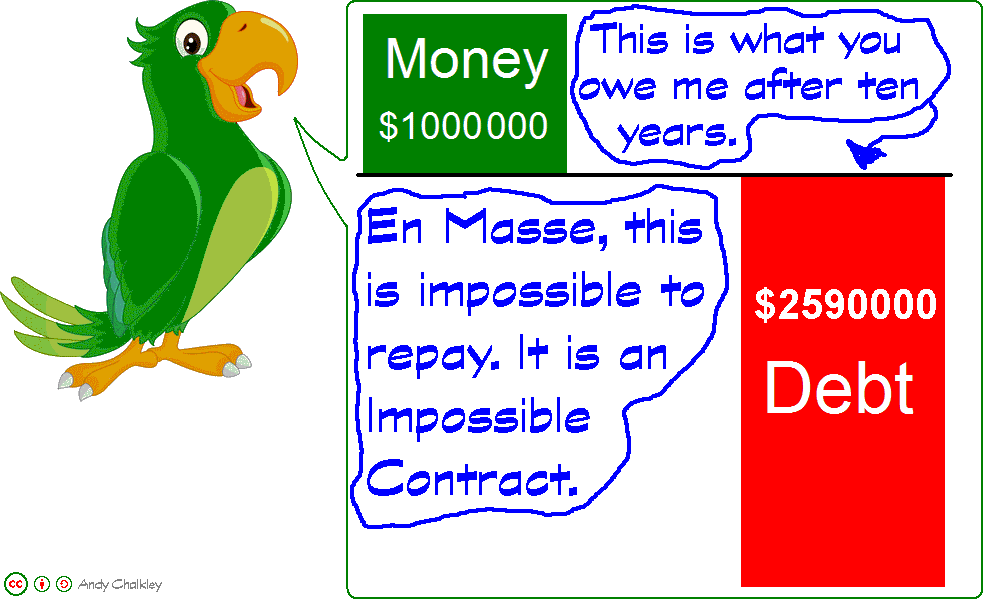
I am not a lone voice in the wind. There are many statements about this characteristic of our money system and these should not be drowned out by those that gain from the system and neither should it be ignored by persons who had a ‘formal economics education’ that fudged over this procedure. I list just a few of the many. The first one sounds like a shrill little voice shouting from inside the Bank of England waiting for the world around to wake up to reality:
Bank of England: “Money creation in practice differs from some popular misconceptions – banks do not act simply as intermediaries, lending out deposits that savers place with them, and nor do they ‘multiply up’ central bank money to create new loans and deposits.” …
“money is largely created by commercial banks making loans.” …
“Indeed, viewing banks simply as intermediaries ignores the fact that, in reality in the modern economy, commercial banks are the creators of deposit money. This article explains how, rather than banks lending out deposits that are placed with them, the act of lending creates deposits – the reverse of the sequence typically described in textbooks.” …
“Commercial banks create money, in the form of bank deposits, by making new loans. When a bank makes a loan, for example to someone taking out a mortgage to buy a house, it does not typically do so by giving them thousands of pounds worth of banknotes. Instead, it credits their bank account with a bank deposit of the size of the mortgage. At that moment, new money is created.” …
“Bank deposits are simply a record of how much the bank itself owes its customers.” [1]
Please read the above at least three times. The message becomes more apparent on subsequent readings.
Ralph Hawtrey, Former Secretary of The British Treasury: “Banks lend by creating credit. They create the means of payment out of nothing.”
Bank of England 2014: “Is it difficult to believe that the Central Bank with the blunt instrument of interest rate control can control private corporation lending habits. As inflation continues to flourish, their control appears to be a carefully controlled myth. …
Creating money in the form of cash notes is illegal and called counterfeiting, however, creating money that is equivalent to cash and lending it to people is apparently legal.” [1]
Marriner Eccles, Governor of the Federal Reserve. 1941: “If there were no debts in our money system there wouldn’t be any money.”
Robert Hemphill 1934, Credit Manager of Federal Reserve Bank, Atlanta, Georgia: “This is a staggering thought. We are completely dependent on the Commercial Banks. Someone has to borrow every dollar we have in circulation, cash or credit. If the Banks create ample synthetic money we are prosperous; if not, we starve. We are absolutely without a permanent money system. When one gets a complete grasp of the picture, the tragic absurdity of our hopeless position is almost incredible, but there it is. It is the most important subject intelligent persons can investigate and reflect upon. It is so important that our present civilization may collapse unless it becomes widely understood and the defects remedied very soon.”
Federal Reserve Bank of Chicago: “The actual process of money creation takes place in commercial banks.” [2]
Federal Reserve Bank of Chicago: “Commercial banks create checkbook money whenever they grant a loan, simply by adding new deposit dollars in accounts on their books in exchange for a borrower’s IOU.” [2]
Please read the next quote one, two, or three times. Andrew packs many items into each sentence.You will not see them all in a single reading.
President Andrew Jackson 1837: “In the hands of this formidable power, thus organized, was also placed unlimited dominion over the amount of circulating medium, giving it the power to regulate the value of property and the fruits of labor in every quarter of the Union, and to bestow prosperity or bring ruin upon any city or section of the country as might best comport with its own interest or policy…Yet, if you had not conquered, the government would have passed from the hands of the many to the hands of the few, and this organized money power from its secret conclave would have dictated the choice of your highest officers and compelled you to make peace or war, as best suited their wishes. The forms of your government might for a time have remained, but its living spirit would have departed from it.” [3]

Prophets of doom might get upset at this, but we have lived with this debt for a long time. I have concluded that we can live with debt. It conveniently makes people work very hard. It makes farmers productive. I have even listened to company bosses tell me that they prefer to hire employees with debt because they jump when they say: “Jump”. I have also concluded that we can live with unpayable debt. We are currently doing so and our society is still functioning. These unpayable debts collectively comprise an Impossible Contract. Lawyers usually give me clever explanations of what constitutes an Impossible Contract. However, to challenge this system with its impossible debt-contracts is to destroy the system. And it is the destruction and collapse of the system that is to be feared. We can live with debt. We can live with impossible debt. But we cannot live with monetary collapse. Food will not leave the farms and the supermarkets will rapidly close their doors. Your gun will become your best friend, as people fight in the street over a sandwich with machine guns. If the money system collapses, you are dead or at least one-third of you will be dead within weeks. Monetary collapse can be more destructive than war.
Abraham Lincoln, 1809-1865: “The Government should create, issue, and circulate all the currency and credits...”
This is not the subject of this chapter. The task is to work out where money comes from. The government has the authority to create the money of the nation. However, the government only creates Cash Currency which comprises a minuscule portion of the Money Supply. In Australia, Cash Currency is 3.5% of the Money Supply. In the UK, Cash Currency is 3% of the Money Supply. In the USA, the figure is about 7.3%. [There is a lot of USA Cash Currency overseas.] The remainder is manufactured by accounting entries in banks. In this previously shown graph, the orange is the cash currency issued by the central bank. The green is credit on the books of banks. Only a tiny percentage exists as cash currency. The bulk of the Money Supply is the green credit in the diagram, none of which originated from the central bank. The central bank only ever created $67 billion out of a total Money Supply of $1760 billion.
When the bank lends you a $1 million to buy a house, it writes $1 million with a plus sign in the seller’s account and $1 million with a minus sign in your account. The action does not damage their balance sheet and nor does it break the rules of double-entry accounting. The million dollars with the plus sign moves from account to account as a method of payment and the debt clings to the debtor. Thus the green in my graphs increases when loans are made and falls when loans are repaid but the debt magnifies with interest. The million plus becomes the vital circulating medium and the debt magnifies with interest to become unpayable. It is the methods of double-entry accounting that allows for this loan procedure to occur. Double-entry accounting requires that: ‘for every increase in one account there is a corresponding decrease in another account’. This utterly brilliant accounting system allows new account money to be created by elementary book entries. When money exists in discrete units as generated by governments, money can only be positive. When money enters a bookkeeping system, the magic of accounting allows negative money, which we call debt.
From the moment that the loan of $1 million is made, there is $1 million more money in the nation and $1 million more debt in the nation. However, interest is owed on the debt at say 10%. Thus, at the end of the year, you owe $1 million plus 10%. At the end of the second year, you owe $1 million plus 10% plus 10%. We now have more debt in the nation than there is money in the nation. The debt grows exponentially in the manner that is taught in high school. If someone has $10 000 in a bank account, the money came from someone who took out a loan. The borrowed money got passed from person to person by adjustment of bank balances. The original borrower is holding around $30 000 in debt corresponding to the $10 000 balance in your account. This next graph shows the ‘Magic of Interest’:
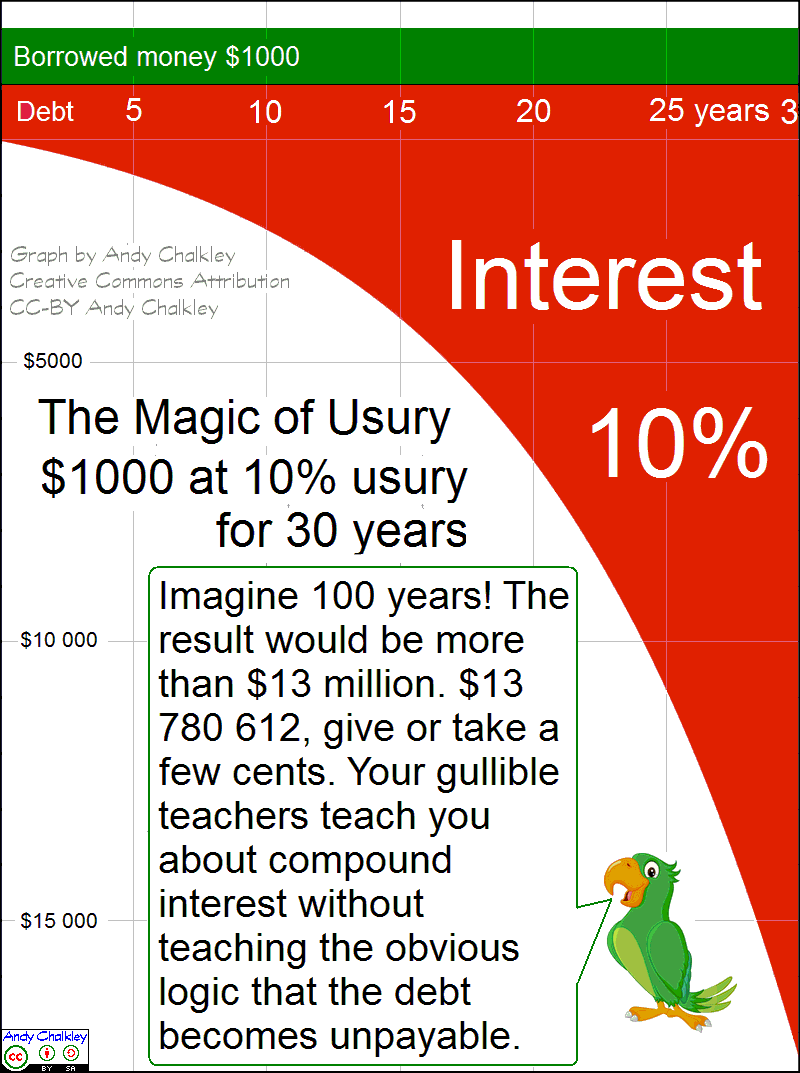
Unfortunately, the teachers fail to teach that this creates ‘more debt than money’. This is a gross failure on behalf of mathematics teachers. I can freely hoe into them as I was a high school mathematics teacher for fourteen years and I was not teaching the obvious either. It was not in the syllabus and so I did not teach it. Collectively the debt is impossible to repay. How could the world mathematics fraternity completely miss this elementary logic? The solution is to constantly create more loans. There is, thus, a constant need to find more people to take out loans and more items on which to hang loans. One has to be quite inventive to find new areas on which to hang loans. I have more to explain on this mechanism, but let us not overload the mind at this stage. More in later chapters.
Mervyn King, Governor of the Bank of England 2012: “... the pretence that debts could be repaid was maintained for far too long.” [4]
In our modern monetary system around 5% of our money is produced by a quasi-government agency of questionable ownership and even more questionable control. [UK 3%, USA 7%, Australia 3.5%.] The remaining ~95% is produced by account entries by private entities. This is not a new phenomenon. It occurred and amplified itself during all the great empires, generally leading to monetary collapse followed by empire collapse. Debt played an important role in the money system of the Roman Empire and contributed to its downfall. Debts were called ‘nomina’, which translates as ‘names’. The names they were referring to were the names in their account books of those that owed money. These nomina were transferable and became a method of payment. The debts were thus transferable and were used as money. The credit became an extension of the Money Supply. The nomina brought the benefits of an expanded Money Supply and a simplicity of payment without physical transfer of coinage but brought the disadvantage of excessive quantities of debt which eventually become unpayable.
At the time of the collapse of the Roman Empire, many of the less well off were borrowing from the well off. The less well off, as a group, became indebted with no chance of escaping the increasing debt.The lending of money and ‘expecting more in return’, is called usury. This usury with its wealth and inescapable debt led to the collapse of Rome. Usury played a significant role in the collapse of the great civilizations of Egypt, Persia, Babylon, Greece and Rome. Credit becomes institutionalised as the main source of money. The wealthy become more adept at acquiring assets in a competitive environment and become more skilled at modifying political procedures to their advantage. The poor become more and more indebted until the credit system collapses when the volume of debt vastly exceeds the volume of money to pay those debts.
Money enters the economy through the granting of loans by private banks. Where this money is first spent, heavily influences the economy. If the banks lend for car loans, car sales will go up. If the banks refuse to lend for car loans, car sales will go down. If banks lend for land and house speculation, land and house prices will rise. Speculation in land and property is usually masked as ‘property investment’ which hides its landlordism nature. Because land is popular, persons will give as much as they can afford to possess their own portion of the land of the nation. House prices will rise to levels unaffordable to young couples and families because the land speculators (investors) will engineer an unbeatable competitive advantage in their favour in the form of tax concessions which effectively become tax subsidies. They also arrange that tax payments be deferred to a future date. Tax on the appreciation of land is deferred to a future date. If the land is never sold, the tax is deferred indefinitely. This speculative activity bloats house prices and create an underclass of house renters who would have been homeowners if higher-income persons had not obtained tax subsidies and delays. The speculators defer tax payments whilst claiming tax deductions. It is the great injustice against the gullible young who are not inclined to rort the system and who are not aware that the system is stacked against them. This creates a whole spectrum of issues that involve welfare, government support, aged persons support and social issues for those brought up in insecure and unstable home tenancy.
The commercial banking sector in alliance with the central bank has complete control over credit creation in both volume and loan type which gives them complete control over the shape of the economy. Cutbacks to any business sector will stifle the growth of that sector. Strong lending into any asset class will inflate that class of asset creating a ‘get rich quick mentality’ amongst the lemming-like small time investors. This ends in tears as the bank stops inflating that area and sends that sector into recession. Recessions are not just a national economics statistic. Each sector of an economy can have inflation and deflation. Booms and recessions can occur in any number of sectors. Similar happens regionally within a nation. If lending is weaker in one region, that region will experience a recession. Allowing commercial banking sector to have full control over the Money Supply creates problems not only with the total magnitude of the Money Supply but also its regional distribution and inconsistencies in the various sectors of the economy.
Some countries implement ‘credit control’ as a way of controlling the Money Supply by controlling the credit creation of banks. ‘Credit control’ was first implemented in 1912 by the German Reichsbank. This was later implemented by the USA Federal Reserve bank in the 1920s and again by other nations. The implementation lasted for many decades. Credit allocations favoured productive credit creation and unproductive credit creation was restricted because it creates asset inflation followed by banking crises. Thus bank credit was not available for purely speculative transactions. Consumer loans were restricted. Bank credit was allowed for productive use. This is an important tool in the government’s arsenal for controlling the economics of the nation. The practice has been removed from the government’s hands by insisting that the central bank be “freed from the influence of politics”. The central bank then avoids using these powers to control the banking industry that it is required to control. When the control of a central bank is removed from government, its control falls to representatives of the banking industry over which it is supposed to exert control.
Credit control is a good way to maintain a stable economy with orderly growth. Fresh credit can be regulated to maintain a mild increase in the Circulating Money and ensuring that the productive areas of the economy have adequate recourse to credit. Speculative and financial areas of the economy can be restricted from credit to prevent asset inflation. Selective asset inflation is not only a dangerous boom-bust activity carried out to make ‘money from money’ giving no productive gain in the nation, it also tends to add to business costs. Under poor management, spectators get an excessive share of available credit which cause financial disturbances. Credit controls regulate the volume of bank advances which then raises or decreases the volume of bank lending. Selective credit controls encourage bank lending into certain sectors and discourage banks from lending for inappropriate purposes. Selective credit controls great influence aid the control of an economy.
The influence over the private banks can be limited. It must be remembered that the banking industry has an army of heavily funded lobbyists that can outnumber the politicians in numbers, incomes and financial resources. The best way to a politician’s heart is through his campaign fund. And politicians get well funded when they are supportive.
Without Credit Controls, the tools available to the central bank are rather blunt and tend not to achieve their objectives. The central bank can become a puppet of the banks that it is required to control. The banking industry has successfully removed the use of the best tools that the central bank has to control the banking industry. Central banks are very successful at creating an illusion that the economy and the Money Supply is being controlled. In reality, central banks are unable to control:
Bank of England 2014: “Is it difficult to believe that the Central Bank with the blunt instrument of interest rate control can control private corporation lending habits.”[1]
The consequence for a nation is dire. However, the arrangement is spectacularly successful at diverting the blame for Money Supply and economic woes away from the commercial banks and onto the central bank and government. A change of government usually completes the blame arrangement. A few ineffective regulatory changes are made to give the illusion that all has been fixed. This continues for a few years until the private banks decide to cease lending. This destroys the Money Supply and the economic welfare of the people another time, whence a new blame-game starts all over again.

In recent decades, the private corporation called the IMF, masquerading as an international bank, has started dictating “best practice” to governments. Governments start to follow instructions from the private banking corporations tied in with “neo-liberal” and “neo-con” thinking processes. This approach recommends (demands):
The consequences are not good. The central bank is freed from its originally designed purposes:
You sometimes hear the popular line put into politicians mouths: “The central bank should be free of government interference.”. One wonders why we put governments in place to govern. Apparently, the central bank believes that it should operate outside of democracy without supervision or regulation. Who ultimately has the authority to create the money of the nation? One might assume that it is the government. The banking system then primes the politicians to have this authority removed from government. It then requires the government to relinquish all control over credit creation.
It thus appears that central banks believe that they should turn central banking policy on its head. Through most of the history of central banking, financing governments, managing exchange rates, and supporting economic sectors have been among the most important tasks of central banks and were accepted as the reasons for their existence. Central Banks now believe that they should now:
They give the illusion of control of the Money Supply by adjusting the interest rate in a proud manner. This has about as much chance of success as King Canute’s attempts at stopping the tide at the seaside.
To make matters worse:
High-profile personnel tend to have a revolving door arrangement as they walk out of mega-banks into treasury jobs and then back to their mega-banks. Their allegiance is likely to be with their ultimate employer, the banks. Their mindset is a banking and borrowing mindset. Similar happened to King Louis before the French Revolution. A man named Necker was put into the King’s treasury and succeeded in getting the king into debt for gold. If gold is of limited supply and is lent, where is one supposed to get the extra gold to pay interest? Although history books try to paint a glowing picture of Jacques Necker, the result of loans contracted during Necker’s incumbency was that the public debt was greatly increased. He appears to have encouraged increasing debt and ‘cooked the books’ to hide the debt. Why would the king be in debt when the king had the authority to create the money? Jacques Necker was encouraging the borrowing from bankers that had created a ‘value’ for gold. Although I am no fan of monarchy, I am neither a fan of any replacement system that is beholden to moneyed interests.